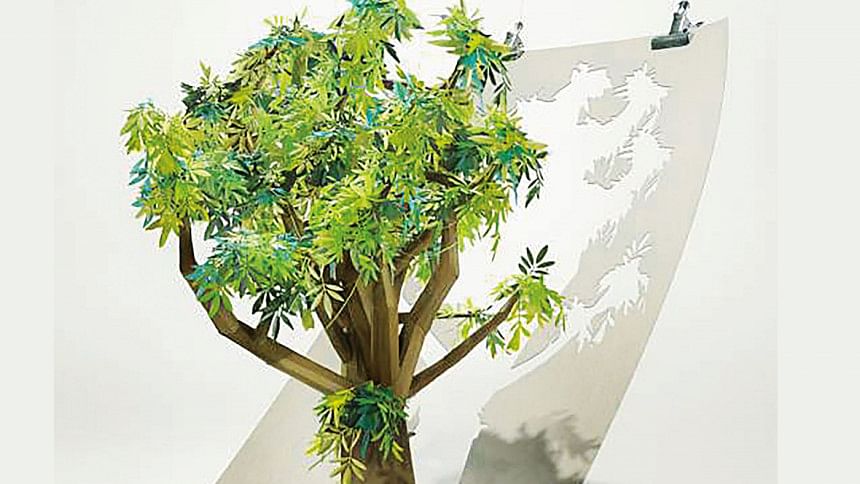Rethinking the use of paper in the judiciary

To comply with this Rule, in almost all cases, advocates file applications, petitions, affidavits etc. in what is popularly known as a legal size paper, measuring approximately 8.5-inch x 14 inches and the same is typed and printed only on one side of legal size papers (though the Rules of 1973 mandates foolscap size papers). Likewise, it is also seen that currently, most judicial and quasi-judicial bodies of Bangladesh use legal size papers for pleadings and other documentation. If comparison is made, it seems that the size of the legal paper is half-inch wider than the foolscap paper and half-inch lengthier. Because of the similarity of the size of these two papers and the availability of legal size papers, people tend to use legal size papers instead of foolscap size papers.
On the other hand, in the governmental offices, an indefinite combination of both legal size papers and A4 size papers (measuring approximately 8.27-inch x 11.69 inches), are used whereas the private sector is mainly dependent on A4 size papers. In many instances, the arbitral tribunals accept petitions in A4 size papers. This gives rise to a disorganised situation in the country as far as the use of the paper is concerned.
Another aspect of the use of legal size paper is that the Supreme Court of Bangladesh (the "SCB") publishes thousands of paper-based cause list every day. It was reported in 2016 by an online newspaper that the SCB spends about BDT 21 crore every year for publishing the printed cause list and has to allocate manpower and transports to carry around 2,600 copies of printed cause list every day. A copy of the cause list contains roughly 400 to 500 pages. For all the printing, almost 65 middle-sized trees are being cut every day. The above numbers, of course, have increased in 2020. This means that the higher judiciary of Bangladesh remains an intensely paper-based system though an effort was made in 2016 to abolish the long-standing custom of using a paper-based cause list and the SCB wanted to go fully online as far as publishing the cause list was concerned. However, that effort failed due to various reasons.
A well-functioning judiciary is a crucial determinant of a country's overall performance. It is widely understood that the judiciary's effectiveness in enforcing the rule of law would not only be conducive to trade, financing, and investment but would also promote social peace and trust. In this way, the SCB has pronounced numerous judgments in favour of the rights of the environment and for the conservation of the same. In the case of Dr. Mohiuddin Farooque vs. Bangladesh &ors., 17 BLD (AD) 1, the Appellate Division states, inter alia, that any act or omission contrary to the protection and conservation of environment will be violative of the 'right to life'. The right to life has been guaranteed as fundamental right under the Constitution of Bangladesh. Furthermore, it is worthy of mentioning that the essence of Article 18A of the Constitution of Bangladesh is 'conservation of environment' which include protection and improvement of environment for the present and future citizens.
The courts of Bangladesh are engaging new technologies in order to build a more efficient judiciary. The government, as part of its vision to establish a 'Digital Bangladesh', is moving ahead with a plan to apply information and communication technology in the judicial system to improve the legal services. The law ministry has undertaken an e-judiciary project worth thousands of crores for digitalising the judiciary. An example of which is the introduction of virtual courts in recent times.
With all these advancements, it is deemed that we can get rid of the "colonial legacy" of using legal size papers and start using only A4 size papers in all aspects of our judicial life. The same can be printed on both sides by leaving lesser margin area as well. A small change in our daily judicial habits could help improve the future. We can save the environment as well as benefit financially by reducing paper consumption. If we start using less papers, we will reduce paper purchase costs as well as printing costs. The cost difference and the financial burden between the two paper sizes are arguably almost double. If photocopying legal size papers cost BDT 1 crore of the tax payers' money per year, we may save half of that money by using A4 size papers.
In the very recent time, the Supreme Court of India has allowed documents to be filed by printing on both sides of A4 papers. A circular stating the same was issued on 13 February 2020. Until recently, their practice was to print legal size paper on only one side. The decision to opt for double-sided court documents was taken in environmental interest.
As the world is racing forward by being welcoming and adapting to new methods and technologies, we should not fall behind and it may be quite troublesome for us if we stay reluctant towards embracing changes. Thus, it is quite clear that the judiciary has a role to play in this regard as part of its continuing role of conserving the environment. We hope, one day this will take us to the destination of the paperless judicial system.
The writer is an Advocate and Associate of Sattar&Co.

 For all latest news, follow The Daily Star's Google News channel.
For all latest news, follow The Daily Star's Google News channel. 



Comments